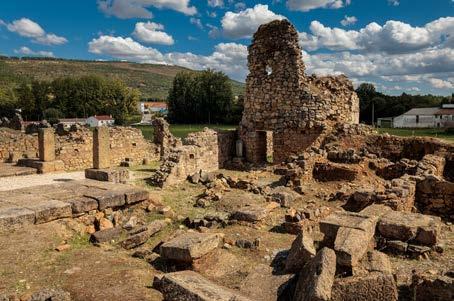
4 minute read
N
by Martin
O MATTER which way you approach Marvão, be it from the north, south, east or west, you’ll only get a few teasing glimpses of what’s to come. It’s not until you pull up into the parking area of the village with the castle on your left and the outreaching views on your right that you really start to get a feel for how spectacular this place is.
Its history
The castle of Marvão’s origins date back to the 9th century when Moorish warrior, Ibn Marúan, took refuge in the hilltop village, which, at the time, was known as Ammaia. Marúan’s influence there is where the name Marvão eventually came from. After being dominated by the Moors for several centuries, Marvão was conquered by the Portuguese in the 12th century. Over the next 700 years, it would witness many more battles and victories, becoming a strategic defensive location thanks to its unbeatable vantage point and close proximity to the Spanish border. Thankfully, however, many of its original 13th-century walls have lived to tell the tale.
Within the village walls
The castle itself sits atop the granite rock that is synonymous with the region. It is characterised by two enclosed courtyards that are a marvel in themselves, while the Torre de Menagem (the high keep of the castle) is the best place to appreciate the village’s farreaching views.
Don’t forget to visit the castle’s water reservoir chamber that was used to collect rainwater during sieges, too. Despite its slightly ominous feel, the large cistern is said to grant the wishes of those who whisper their desires into its echoey depths. It’s located at the entrance to the castle.
However, it might take you a while to get to Marvão’s crowning glory – the castle. You’ll no doubt find yourself leisurely meandering around its quaint streets, nosing around its quirky gift shops, and stopping off for a refreshment in one of the several restaurants/bars that arguably have some of the best views in Portugal. As you wind your way up to the castle, look out for the typical Alentejo houses built out of granite, wrought-iron balconies, gothic architecture and Manueline windows.
Other must-sees are the Capela do Espírito Santo (built in 1573 in the Renaissance style) and the Igreja de Santa Maria, which is now home to the municipal museum.
Just outside the walls but still technically within Marvão are the Igreja de Santiago and the Convent of Nossa Senhora da Estrela. Both were built in gothic styles with the former being constructed in 1321 and the latter in 1448.
While you’re in the area…
If you really want to get a feel for Marvão and its history, you might want to begin your journey there at the bottom of the 850-metre climb in the village of Portagem. This too boasts a rich and interesting history.

One of its most famous landmarks is the 15th-century grey stone Roman bridge with four arches and cobbled road. It was here that Jews paid their taxes to enter Portugal as they fled the persecution in Spain. In 1996, a memorial plaque was placed on the bridge to commemorate 500 years since the 1496 expulsion.
The town of Castelo de Vide, which is nestled right next to Marvão, is also home to one of the most crucial examples of Portugal’s Jewish population. Its Jewish quarter is said to be one of the best-preserved examples in the country and dates back as far as the 13th century, offering a magical example of Gothic architecture.
In fact, the whole of Castelo de Vide has a wonderful feeling of being transported back in time. As you navigate your way through its narrow medieval streets you’ll find a variety of monuments, rustic white houses and yet another historic castle. Despite being ‘younger’ than the castle of Marvão (the origins of Castelo de Vide’s castle appear to be around the 14th century), it, too, has witnessed numerous battles and retains some of its original features today.


The town is also home to 24 churches no less! Of note is the Capela do Salvador do Mundo, which, having been built in the 13th century, is the oldest in the region. Inside, you’ll find Portugal’s signature blue and white azulejos and outside, expansive views across the Serra de São Mamede.
It is its location within the Serra de São Mamede that has seen Castelo de Vide become renowned for its rich, natural qualities. This includes the Fonte da Mealhada and Fonte da Vila, which are said to boast wonderful healing properties. You might want to take note of another folklore in the area before drinking from Fonte da Mealhada, though. It is said that anyone who does will one day find themselves returning to Castelo de Vide to get married!
Finally, just south of Marvão Castle are the ruins of Ammaia, the Roman city mentioned earlier. When constructing Marvão, many of the stones and other artefacts from the ruin of this city were used. Despite only a few remnants being left today, recent conservation and restoration works have established a fascinating museum and insight into the past.
Best Time to Visit?
Thanks to its remote location and thankful lack of commercialisation, you won’t feel like you have to battle with crowds of people at any time of the year. But if you want to really embrace all of the romance and mystique Marvão has to offer, plan a visit to coincide with the November Chestnut Festival.
Not only are there some of the finest roasted chestnuts on offer, but you’ll also find many local artisans selling handcrafted products, local wine, cheeses, sausages, pastries, jams, liqueurs and much more. It’s due to be held on 11 and 12 November this year and will feature live music throughout the day and night as well as plenty of other festivities.










